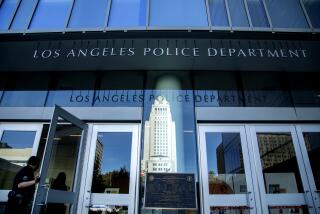Anaheim Will Shift Officers to Gang Unit : Law enforcement: Until new officers can be hired, the Police Department will transfer some to what is currently a one-man gang detail.
ANAHEIM — Police Officer Lee Smith spends a lot of time fighting the city’s gang problem. But rather than waging the fight from the front lines of gang-ridden neighborhoods, he does it from behind his desk at the Anaheim Police Department.
Not that Smith would not like to be out in the field. Saddled with office work, such as compiling information about gangs and their members, he can do little more as the lone officer in the department’s gang unit. Besides, officers are instructed by the department not to go into tougher neighborhoods alone when it is dark--which is when gang activity peaks.
“I feel like I did when I was flying in a helicopter in the Marines, and I looked out 360 degrees around me, and (you) don’t see land anywhere, and they make you jump, and you just start jumping,” Smith said. “There have been days when it’s been extremely frustrating.”
Since the department first established its gang unit six years ago, the number of gangs in the city has jumped from eight to 35, and the number of gang members has risen from 170 to more than 500. But during the same period, the number of officers in the unit has remained at one.
Now, Police Chief Joseph T. Molloy is planning a major shuffle of personnel to boost the gang unit with seven additional officers.
Mayor Fred Hunter has promised the Police Department that the city will pay for another five officers on the gang detail, but Molloy still plans to beef up the unit immediately by transferring officers from other areas of the department. Two more gang officers are to be funded by a federal grant.
“He will not be the Lone Ranger any longer,” Hunter said, referring to Smith. “We’re definitely beefing up (the gang unit). It’s pretty obvious we have a gang problem.”
Residents who have watched the escalating gang problem change the character of their neighborhoods will be pleased to see more gang-unit cops on the streets, but they still question why the city has taken six years to respond to the ever-worsening gang situation.
They see the havoc gangs wreak on the community, ranging from pesky graffiti to deadly drive-by shootings, and want more gang prevention programs.
Many want Anaheim to follow an example set by Santa Ana, which in March increased its gang unit from eight officers to 21. Police say, however, that Santa Ana’s gang problem is far more serious than Anaheim’s.
“We have parks that are unsafe, physical abuse of property, assaults--like the stabbing of my son--and drive-by shootings, which we didn’t have a few years ago,” said Anaheim resident Doug Gibson, who has been an anti-gang advocate since his son was stabbed by members of a local gang a few years ago. “I don’t think the City Council has a grasp and understanding of what is going on in the trenches.
“If the police aren’t given the support to do their job, we’re going to lose the city to the gangs. And in turn, (council members) need to put the commitment and support into diversion programs for these neighborhood kids. If you don’t have one and the other working together, you don’t have a total program.”
Molloy said that some residents’ criticisms are unfounded and that police are giving a high priority to the gang problem. He said other officers assist Smith in nighttime operations, such as gang sweeps, even though they are not technically part of the gang unit.
“People keep saying, ‘You’ve got just one guy,’ but we’ve had other people out there working the gang detail,” Molloy said.
Councilman Tom Daly expressed his concern at a recent meeting. He questioned how police were spending their $47-million budget and urged them to shuffle their resources to better combat the growing gang problem.
“I’m a little mystified about why we don’t have a little more of a concentrated effort citywide,” Daly said. “I’ve just got to believe we can move money around in a budget that large for these priority issues.”
The Police Department has 1.3 officers per 1,000 residents, contrasted with the county average of 1.47 per 1,000. But despite the thinner staff and vocal citizen concerns about gang problems, city voters in a March 5 special election overwhelmingly rejected Measure D, which would have imposed a tax increase to hire more police, firefighters and paramedics.
Last month, the council decided to spend federal grant money to hire two more gang officers. However, officials said that those funds will expire in one year and that there is no guarantee the officers will remain in the gang unit once the money runs dry.
“I can only assume I’m not going to get additional police officers,” Molloy said. “Maybe this is a good time to jump on (restructuring).”
Currently, Smith does nighttime gang sweeps about once a month with the help of other officers.
Smith is hopeful that with more officers, the unit will be able to do more active law-enforcement on the streets.
“We’d be able to share the caseload and actually begin acting like a gang unit,” he said.
“Everyone agrees there should be a bigger gang unit--the officers, the administration,” Smith said. “It’s just a matter of manpower and money. As a police officer, you see this stuff going on, and it’s frustrating. I can only do so much.”
More to Read
Sign up for Essential California
The most important California stories and recommendations in your inbox every morning.
You may occasionally receive promotional content from the Los Angeles Times.











